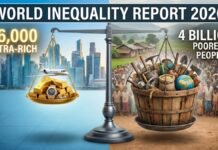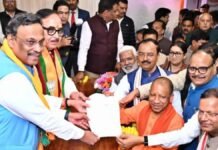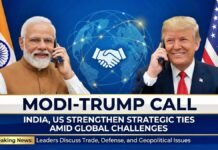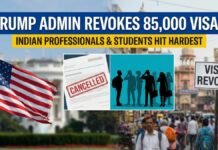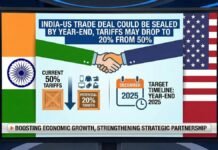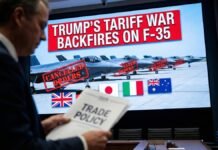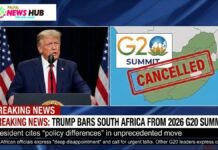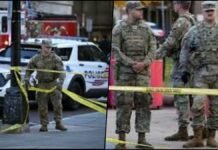
Key Points:
- An Indian-origin woman passionately confronted US Vice President JD Vance at a Turning Point USA event at the University of Mississippi on Wednesday, October 29, 2025, over the Trump administration’s strict immigration policies
- The woman, wearing a bindi and wrapped in what appeared to be a traditional shawl, challenged Vance’s stance on reducing legal immigration, asking: “When did you decide we were too many?”
- Vance stated the US must “get the overall numbers way, way down” and accept “far fewer” legal immigrants, though he didn’t specify exact numbers
- The woman’s emotional question received widespread applause from students, as she stated: “You made us spend our youth and wealth in this country, how can you tell us we don’t belong here?”
- During the same event, Vance publicly expressed hope that his Hindu wife, Usha Vance, would “one day be moved” to embrace Christianity, though he acknowledged she has free will
- More than 2,700 Indians have been deported from the US since January 2025, according to India’s Ministry of External Affairs
New Delhi: The atmosphere at the University of Mississippi became charged on Wednesday evening, October 29, 2025, when an Indian-origin woman confronted US Vice President JD Vance with pointed questions about the Trump administration’s increasingly restrictive immigration policies. The exchange, which occurred during a Turning Point USA event honoring the late political activist Charlie Kirk, quickly went viral on social media as the woman passionately challenged Vance’s position on legal immigration.
The woman, identifiable by her bindi and traditional Indian attire, directly questioned Vance during the question-and-answer session: “When you talk about too many immigrants here, when did you guys decide that number? Why did you sell us a dream? You made us spend our youth and wealth in this country and gave us a dream”. Her voice rising with emotion, she continued: “You don’t owe us anything; we have worked hard for it. Then how can you, as the VP, say that ‘we have too many of them now and we are going to take them out’ to people who are here rightfully by paying the money that you guys asked us?”
'You Sold Us A Dream & Now You Want To Stop It' Watch South Asian Student Take On JD Vance Over Faith, Immigration & H1-B Visas
— RT_India (@RT_India_news) October 30, 2025
📹 Fox News pic.twitter.com/Sh2xunknHG
“We Don’t Belong Here Anymore?”
The woman’s most powerful moment came when she accused the administration of betraying immigrants who followed legal pathways to America. “You gave us the path, and now how can you stop it and tell us we don’t belong here anymore?” she asked, her question drawing significant applause from the audience of approximately 10,000 attendees. She clarified after the applause that she had “no intention of causing a scene,” to which Vance quipped with a smile, “We are not close to causing a scene. Don’t worry”.
The confrontation highlighted growing frustration among legal immigrants, particularly from India, who have invested years and substantial financial resources into building lives in the United States through programs like H-1B visas and student pathways. According to India’s Ministry of External Affairs, more than 2,700 Indians have been deported from the US since January 2025, including a recent batch of 35 individuals, most of whom were handcuffed during deportation.
Vance’s Defense of Restrictive Policies
Vance, a leading architect of the Trump administration’s immigration overhaul, defended his position by stating that the US must “get the overall numbers way, way down”. While he did not specify an exact cap on legal immigration, he indicated current levels are “far higher than what’s sustainable” and should be reduced to “far less than what we’ve been accepting”. He emphasized the need to protect what he called America’s “social fabric” through stricter vetting processes.
In his response to the woman’s question, Vance argued: “Just because one person or 10 people or 100 people came in legally and contributed to the United States of America, does that mean that we are thereby committed to let in a million or 10 million or 100 million people a year in the future? No, that’s not right”. He added that while he respects people who came through lawful immigration pathways, the government must determine sustainable immigration levels for the country’s economic and social structure.
Vance further stated that what worked for the United States decades ago does not necessarily work for the country now, emphasizing that his job is to “look out for the people of the United States” rather than accommodate all those who wish to immigrate. However, he notably avoided providing a direct answer to the woman’s core question about why the administration is changing course after encouraging immigrants to build their lives in America.
Impact on Indian Immigrants
The confrontation has resonated deeply within the Indian-American community, particularly among H-1B visa holders and students who face increasing uncertainty about their futures in the United States. The Trump administration has implemented strict policies affecting legal immigration through changes to the H-1B system, with approximately 6,000 visas of international students also being revoked.
The woman’s passionate questioning gave voice to the concerns of millions of legal immigrants who invested their “youth, wealth, and trust” in the American Dream, only to face potential displacement despite following all legal requirements. Her statement that “we have worked hard for it” emphasized that legal immigrants are not seeking handouts but recognition of their contributions and adherence to the system established by the US government.
Online Reactions and Viral Spread
The video of the confrontation quickly went viral across social media platforms, sparking intense debate. While many praised the woman for her courage in challenging the Vice President, others, particularly within MAGA circles, criticized her, with some calling her a “delusional Hindu H-1B invader,” revealing the toxic rhetoric surrounding immigration debates. The incident has become a flashpoint in the broader conversation about America’s relationship with legal immigration and the treatment of those who followed prescribed pathways to residency.
Questions About Interfaith Marriage
During the same event, another student raised questions about Vance’s interfaith family, asking how he, as a Christian vice president, views his Hindu wife and their intercultural household. This question led to a revealing exchange where Vance publicly expressed his hope that Usha Vance would eventually convert to Christianity.
“Most Sundays she will come with me to church,” Vance told the crowd of approximately 10,000 people. “As I’ve told her, and I’ve said publicly, and I’ll say now in front of 10,000 of my closest friends: Do I hope eventually that she is somehow moved by the same thing that I was moved by church? Yeah, I honestly do wish that. Because I believe in the Christian gospel and I hope eventually my wife comes to see it the same way”.
Vance’s Spiritual Journey and Family Dynamics
Vance acknowledged that his statement might seem unusual but added a caveat: “But if she doesn’t, then God says everybody has free will, and so that doesn’t cause a problem for me”. He revealed that when he met Usha at Yale Law School, he “would consider myself an agnostic or an atheist, that’s what she would have considered herself as well”. Ironically, it was Usha who helped JD Vance, then an agnostic, find his Christian faith.
During his remarks, Vance noted that Usha “grew up in a Hindu family, but not a particularly religious family”. The couple decided to raise their three children in the Christian faith, with their two older children enrolled in a Christian school. Vance mentioned that their elder son, aged eight, received his First Communion last year, demonstrating the family’s commitment to Christian education despite Usha’s Hindu background.
Context of Immigration Crackdown
The confrontation comes amid a broader crackdown on immigration under the Trump administration’s second term, with Vance serving as one of the most vocal advocates for restrictive policies. The administration has not only focused on illegal immigration but has increasingly targeted legal pathways, raising concerns among the millions of immigrants who came to America through official channels and contributed to the economy, innovation, and society.
The woman’s question, “When did you decide we were too many?” encapsulates the frustration of legal immigrants who feel betrayed by a system that once welcomed them but now seeks to limit their numbers and potentially remove those already established in the country. Her pointed reference to “our youth, our capital, and our trust” highlights the substantial investments legal immigrants have made in America, making the administration’s policy shift particularly jarring for those who believed they were following the promised path to the American Dream.














